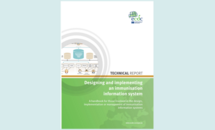Handbook on designing and implementing an immunisation information system
The handbook collates guiding principles and good practices from all aspects of immunisation information systems; from development to implementation.
Executive summary
Immunisation information systems (IIS) are confidential, population-based, computerised information systems that record, store, and provide access to consolidated individual immunisation information. The full potential of IIS lies in their ability to better support vaccination programme monitoring by providing access to a large set of data on vaccination.
The handbook proposes strategies that build on the experiences of IIS experts; provides case studies from actual programmes to highlight particular aspects of IIS practice, including functionalities, benefits, challenges, and implementation. It aims to share experiences and explore ideas that IIS experts consider valuable for developing a new IIS or upgrading an existing system,.
The handbook is intended for all those involved in the design, implementation, management or continuous improvement of IIS, such as immunisation programme managers and operational IIS staff; and also public health experts and policymakers.
By generating quality and timely evidence on vaccination, an IIS can support authorities in guiding public health actions and constitute an integral part of well-functioning vaccine programmes. When interoperability of the IIS with other health information systems (e.g. hospital databases and safety registers) is achieved, IIS have great potential to be the most robust and systematic approach for providing data to study the safety and effectiveness of specific vaccines.
Download

Read more on the ECDC website
Information systems to record information about vaccination
Strong information systems to digitally record information about vaccination, Immunisation Information Systems (IIS), are an integral part of well-functioning vaccine programmes since they hold data both at the personal and population levels.






